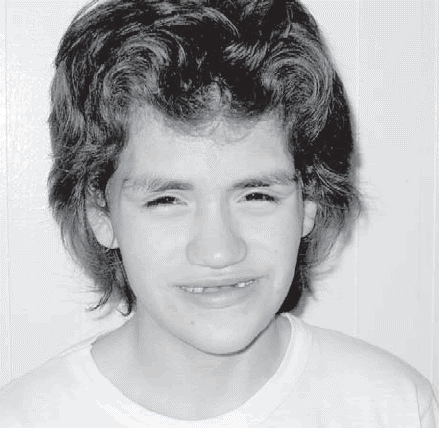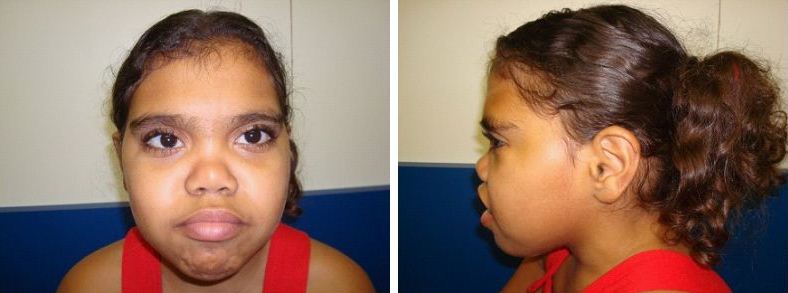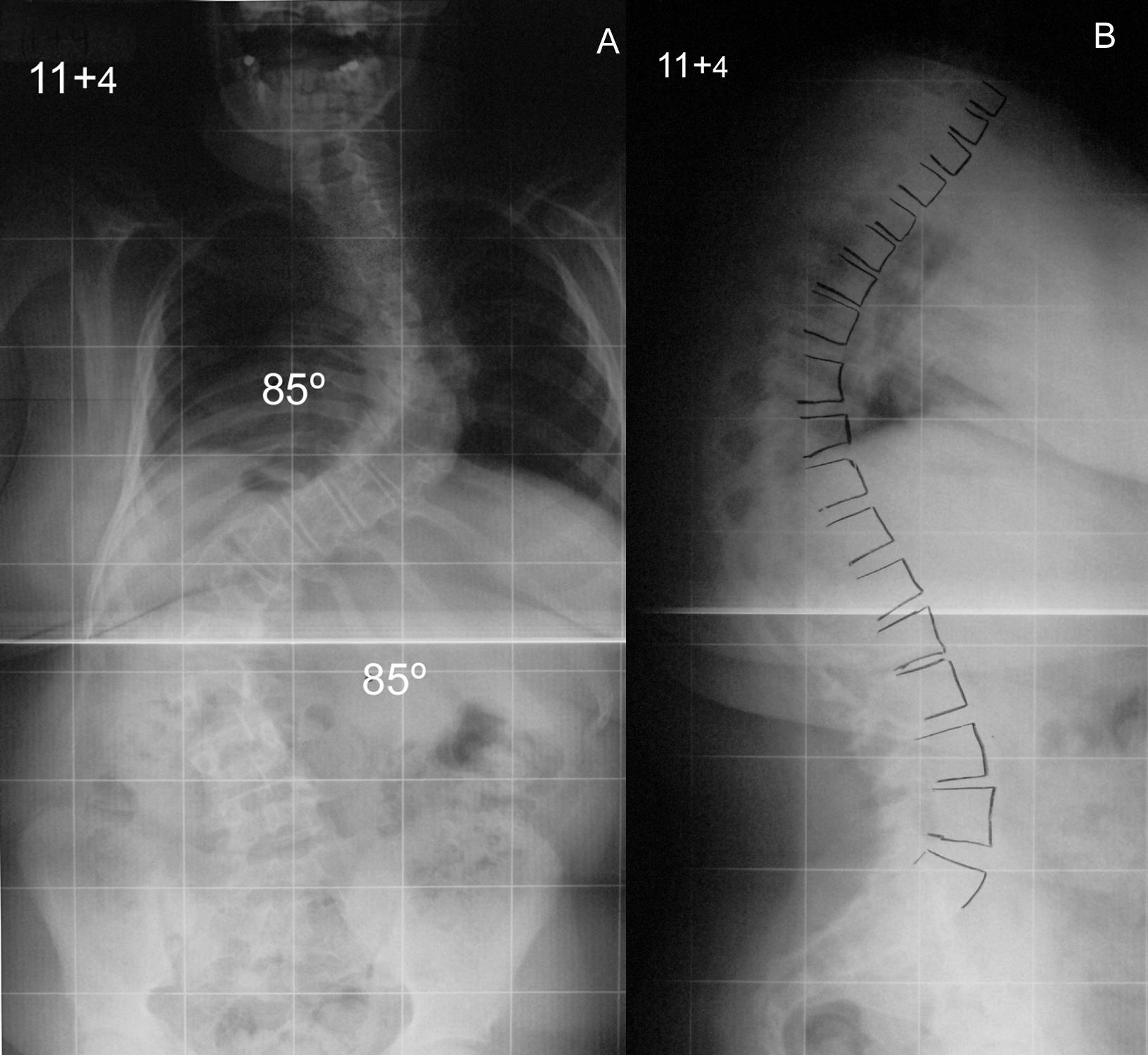Smith-Magenis Syndrome (SMS)
Clinical information
Smith-Magenis syndrome is a genetic condition that affects many different parts of the body. Although the disease varies considerably from patient to patient, its major features include intellectual disability that may worsen or appear with time, behavioral quirks and problems, a distinctive set of facial features, and sleep disturbances. It occurs in roughly 1 in 15,000 to 25,000 births (1, 2).
Many people with SMS have endearing personalities and engaging senses of humor. Unfortunatley, they are often prone to injuring themselve, such as by head banging, self-biting, face slapping, skin picking, yanking at nails, or inserting objects into themselves. In particular, the last two characteristics on that list are highly suggestive of SMS. Patients may also hug themselves tightly, and are easy to excite and distract. Other signs and symptoms of SMS include the following:
- Intellectual disability
- Delayed speech development
- Hoarse voice
- Daytime drowsiness and/or naps
- Bedwetting
- Snoring
- Frequent ear infections
- Hearing loss
- Hypotonia (floppiness), especially in infants
- Scoliosis, lordosis, and other problems of the spinal column (see photo below)
- Short stature (size may be normal at birth)
Signs of Smith-Magenis syndrome
Some features of SMS are age-dependent. These features include a hoarse voice and brachycephaly (a flat head). Additionally, people with Smith-Magenis syndrome tend to have characteristic facial features. The photographs on this page show examples of some of these features. For example, the girl at the top of the page has heavy eyebrows, a large forehead, jaw prognathism, and a short philtrum (the groove below the nose). The Hispanic girl below also has heavy eyebrows and a short philtrum. The Caucasian girl below has a squred face, as does the Hispanic boy below. Although facial characteristics become more obvious with age, the following are common facial features in SMS:
- Square or broad face
- Short philtrum (groove below the nose)
- Midface hypoplasia (the center of the face is underdeveloped compared to the eyes, forehead, and lower jaw)
- Brachycephaly (flat head)
- Upper lip eversion (the upper lip is directed and juts outward and upward)
- Prognathism (the lower jaw is large and juts forward)
- Mono-eyebrow (the eyebrows join in the middle of the face)
- Strabismus (one eye is directed inward or outward; see photo below)
Facial characteristics in SMS
Readers may wish to consult a review about SMS (3,4) and/or a description of facial characteristics in this syndrome (5). In addition, the links at the right under General Information contain extensive clinical descriptions of SMS.
SMS is caused by a deletion of genetic material on chromosome 17. This deletion is usually sporadic, meaning that it isn't inherited from one or both parents. The deletion usually happens at the time of conception, and the chances of having a second child with SMS are very low (<1% according to the the Gene Reviews article linked to at the right). However, in rare cases, a parent has a chromosomal abnormality that may be passed on to other children. Parents of children with SMS should consult a geneticist.
The definitive diagnosis of SMS relies on genetic testing that finds either a deletion in 17p11.2 (includes the gene RAI1), or a mutation in the gene RAI1. The link at the right under Testing provides a list of laboratories that perform genetic testing for mutations in SMS.
The differential diagnosis for SMS includes 1q36 deletion syndrome, 9q34 deletion syndrome, 22q11.2 deletion syndrome (DiGeorge syndrome or Velocardiofacial syndrome), Down syndrome, Prader-Willi syndrome, Sotos syndrome, and Williams syndrome. Additionally, SMS may be misdiagnosed as autism, ADHD, obsessive-compulsive disorder, or oppositional defiant disorder.
References
- 1. Smith AC et al. (2005) Overview of Smith-Magenis syndrome. J Assoc Genet Technol 31:163-167. Abstract on PubMed.
- 2. Greenberg F et al. (1991) Molecular analysis of the Smith-Magenis syndrome: a possible contiguous-gene syndrome associated with del(17)(p11.2). Am J Hum Genet 49:1207-1208. Full text on PubMed.
- 3. Moretti-Ferreira D (2013) Intellectual and Behavioral Disabilities in Smith-Magenis Syndrome. Developmental Disabilities - Molecules Involved, Diagnosis, and Clinical Care; A Salehi, editor Chapter 3:65-79. Full text.
- 4. Gropman AL et al (2006) Neurologic and developmental features of the Smith-Magenis syndrome (del 17p11.2). Pediatr Neurol 34(5):337-350. Abstract on PubMed.
- 5. Allanson JE et al (1999) The face of Smith-Magenis syndrome: a subjective and objective study. J Med Genet 36:394-397. Full text on PubMed.
- 6. Bronberg DR et al. (2008) Smith-Magenis syndrome: case report and review. [Article in Spanish] Arch Argent Pediatr 106(2):143-154. Full text from Scielo.
- 7. Vilboux T et al. (2011) Molecular analysis of the Retinoic Acid Induced 1 gene (RAI1) in patients with suspected Smith-Magenis syndrome without the 17p11.2 deletion. PLoS One 6(8):e22861. Full text on PubMed.
- 8. Tsirikos AI et al. (2010) Surgical treatment of scoliosis in Smith-Magenis syndrome: a case report. J Med Case Rep 4:26. Full text on PubMed.





